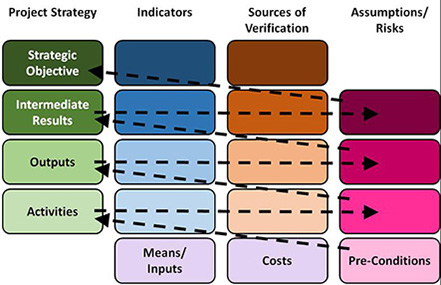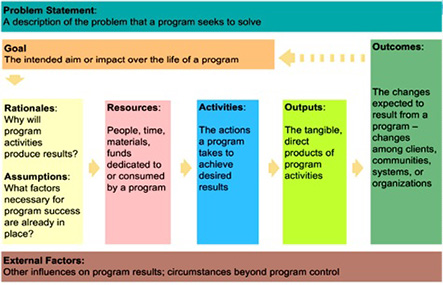A Logframe is another name for Logical Framework, a planning tool consisting of a matrix which provides an overview of a project’s goal, activities and anticipated results. It provides a structure to help specify the components of a project and its activities and for relating them to one another. It also identifies the measures by which the project’s anticipated results will be monitored.
The logical framework approach was developed in the late 1960s to assist the US Agency of International Development (USAID) with project planning. Now most large international donor agencies use some type of logical or results framework to guide project design.
Logical Framework Structure
A Logical Framework (or LogFrame) consists of a matrix with four columns and four or more rows which summarize the key elements of the project plan including:
- The project's hierarchy of objectives. The first column captures the project’s development pathway or intervention logic. Basically, how an objective or result will be achieved. Each objective or result should be explained by the objective or result immediately below. Although different donors use different terminology, a LogFrame typically summarizes the following in its first column:
- The GOAL / OVERALL OBJECTIVE/ DEVELOPMENT OBJECTIVE
- The PURPOSE / IMMEDIATE OBJECTIVE
- The OUTPUTS
- The ACTIVITIES
In developing a logframe, it is very important to pay attention to how the objectives and results are formulated. For reference, see Catholic Relief Services' (CRS) Guidance for Developing Logical and Results Frameworks.
The second and third columns summarize how the project’s achievements will be monitored and consists of the following:
- Indicators- a quantitative or qualitative measurement which provides a reliable way to measure changes connected to an intervention. In essence “a description of the project’s objectives in terms of quantity, quality, target group(s), time and place”
- Sources of verification- Describes the information sources necessary for data compilation that would allow the calculation of indicators.
Developing objectively verifiable indicators must also be a very careful process. The USAID provides tips for selecting performance indicators.
Lastly, the final column lists the following:
- Assumptions -the external factors or condition outside of the project’s direct control that are necessary to ensure the project’s success.
Example of the Logical Framework Structure and Intervention Logic

Logical Frameworks can look very different from one another depending on a donors requirements and the design team. The terminology used also differs between donors. See “The Rosetta Stone of Logical Frameworks.” Other similar tools include the Logic Model which is also an overall summary of a project plan and anticipated results or outcomes. The following example is more in the format of a Logic Model:

Strengths of the Logical Framework Approach
- It draws together all key components of a planned activity into a clear set of statements to provide a convenient overview of a project.
- It sets up a framework for monitoring and evaluation where planned and actual results can be compared.
- It anticipates project implementation and helps plan out development activities.
Weaknesses of the Logical Framework Approach
- It may cause rigidity in program management.
- It is not a substitute for other technical, economic, social and environmental analyses.
- LogFrames are often developed after the activity has been designed rather than used as the basis for design.
- It can stifle innovative thinking and adaptive management.
Useful Resources:
- Project Cycle Management Guidelines European Commission
- Handbook on Planning, Monitoring and Evaluating for Development Results UNDP (2009)(Exists in several languages including Russian)
- Tools for Development: A Handbook for Those Engaged in Development Activity Department for International Development (DFID) UK (2003)
- USAID: Project Design Guidance (2011)
- The Logframe Handbook: A Logical Framework Approach to Project Cycle Management World Bank
References:
1European Commission (2004). Project Cycle Management Guidelines. Accessed February 19, 2015 from: http://ec.europa.eu/europeaid/sites/devco/files/methodology-aid-delivery-methods-project-cycle-management-200403_en_2.pdf
2From Ministry of Fisheries and Aquatic Resources (DFAR) Sri Lanka; Icelandic International Development Agency (ICEIDA); and United Nations University Fisheries Training Programme (UNU-FTP).
World Bank (2005). The logframe Handbook; A Logical Framework Approach To Project Cycle Management. Accessed February 19, 2015 from:
http://www-wds.worldbank.org/external/default/WDSContentServer/WDSP/IB/2005/06/07/000160016_20050607122225/Rendered/PDF/31240b0LFhandbook.pdf
About the Author
Kirsten Bording Collins is an experienced evaluation specialist providing consulting services in program evaluation, planning and project management. She has over ten years of combined experience in the nonprofit, NGO and public sectors working both in the U.S. and internationally. Kirsten's areas of expertise include: program evaluation, planning, project management, evaluation training and capacity-building, mixed-methods, qualitative analysis, and survey design. Kirsten holds a MA in International Administration from the Korbel School of International Studies, University of Denver. Kirsten grew up in Copenhagen, Denmark and currently lives in Washington, DC.
Connect with Kirsten on LinkedIn.
________
To learn more about American University’s online Graduate Certificate in Project Monitoring and Evaluation, request more information or call us toll free at 855-725-7614.



